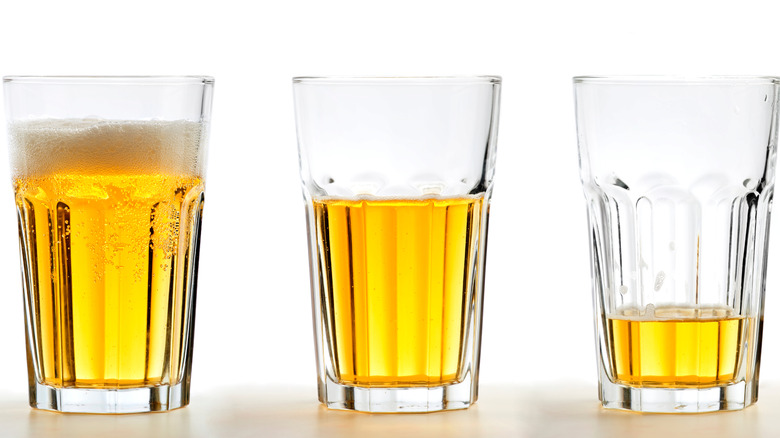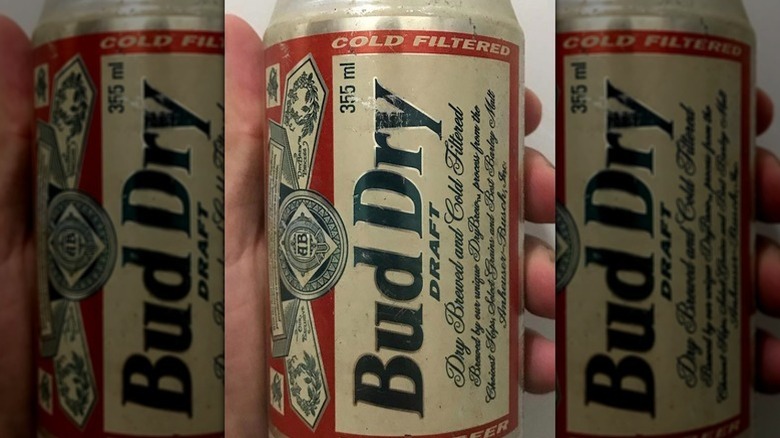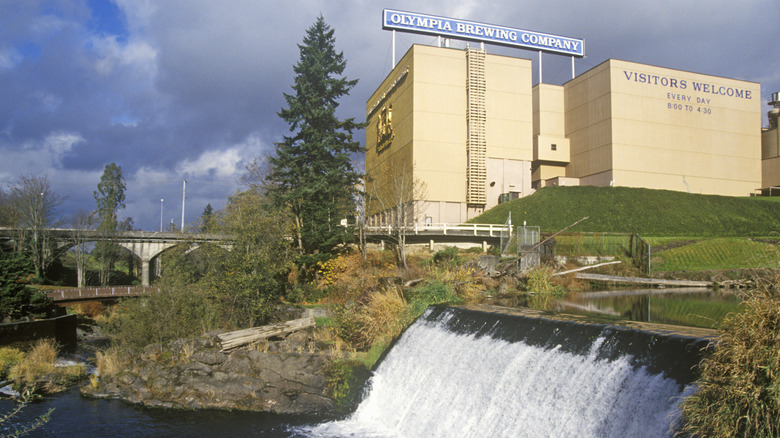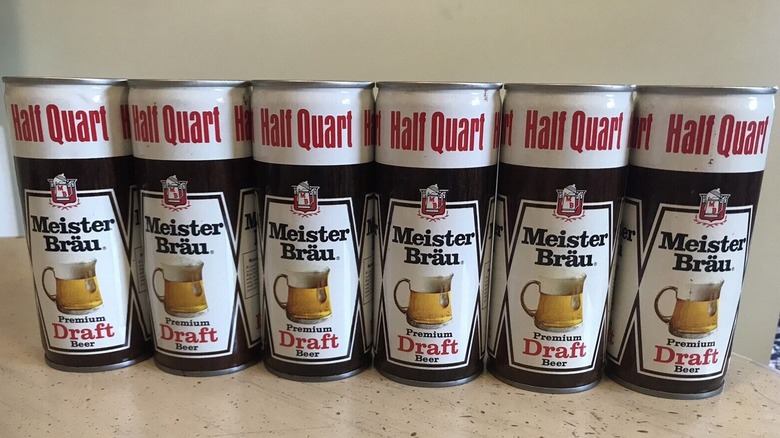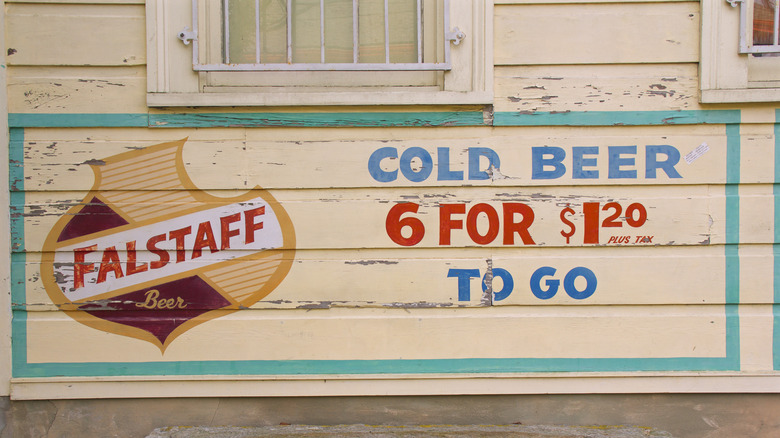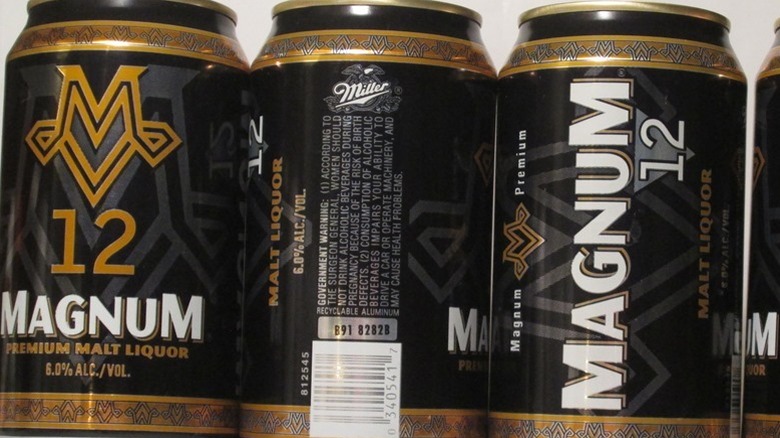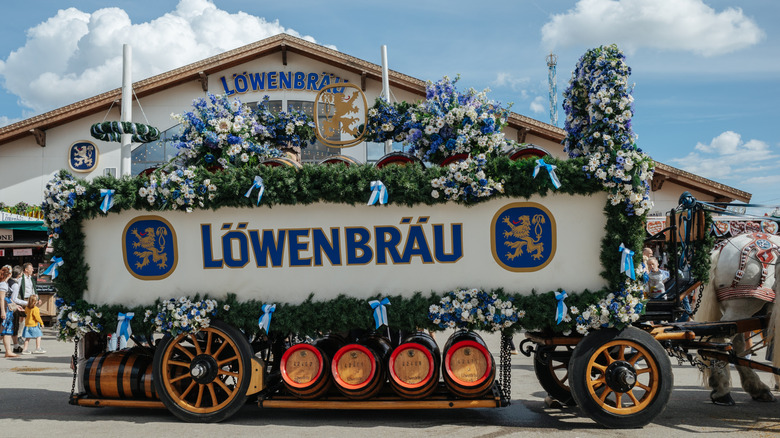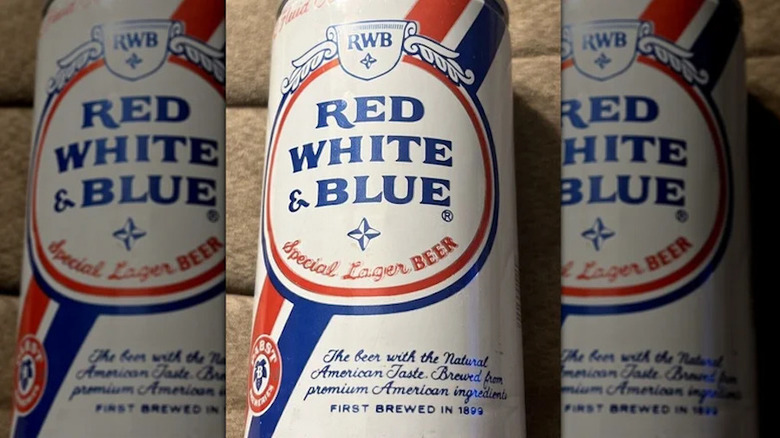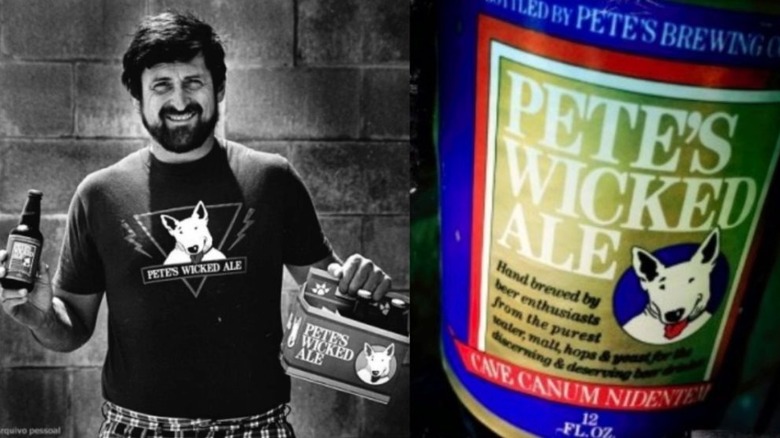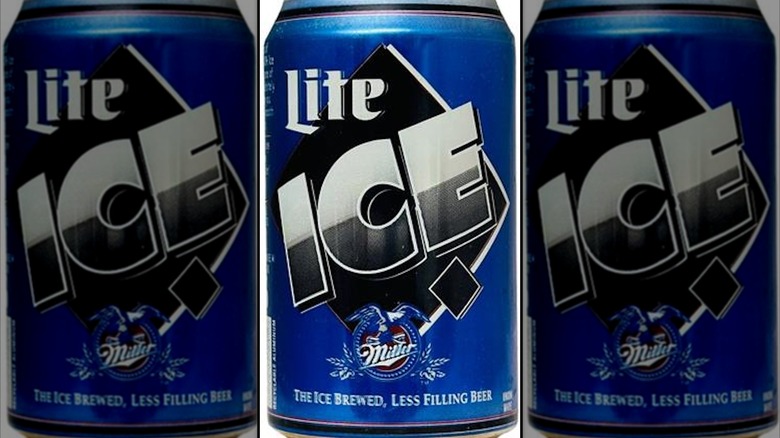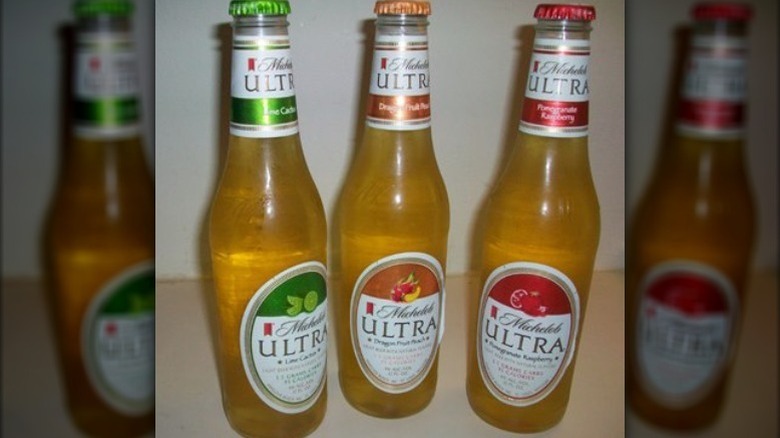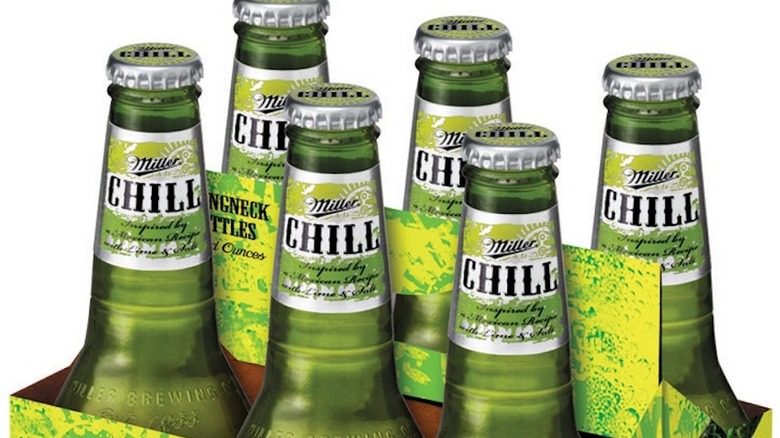Discontinued Beers We'll Never See Again
We may receive a commission on purchases made from links.
Americans sure do love their suds. We're a beer-drinkin' bunch, evidenced by the fact that the average adult over 21 years of age in the United States drinks more than 28 gallons of beer annually. That's about a six-pack every week, or close to two kegs each year. In fact, the U.S. is number two in total beer consumption in the world, behind only China. So it should be no surprise that we have just shy of 10,000 total breweries pumping out enough brewskis to keep our collective thirsts slaked.
The craft beer craze began in earnest in the 2010's, but before that, less than a dozen large breweries made up about 90 percent of the U.S.'s overall beer production. Nationwide domestic brands such as Budweiser, Miller, and Coors ruled the grocery store coolers and neighborhood bars, with import giants such as Heineken and Corona grabbing market share as well. The parent breweries that produced these styles often expanded out to include other multiple product extensions and individual brands of beer in their portfolios. Many of them were top-sellers enjoyed by millions of beer-loving fans.
So, what were these tasty malt beverages of old — and where did so many of them go? Let's take a look at some of those discontinued beers that vanished, probably forever.
Bud Dry
The '90s was the decade of dry beer. Although dry beer was originally introduced in Japan in 1987 when Asahi Super Dry hit the shelves, the dry beer craze in the United States actually began in the spring of 1990 when America's most popular beer line, Budweiser, introduced Bud Dry. Its original slogan "Why Ask Why? Try Bud Dry" was a nod to the company's understanding that dry beer was still a novel concept to most beer drinkers and that they should give it a taste.
Right out of the gate, Bud Dry was a hit, riding the coattails of Budweiser's monster brand popularity and the marketing muscle of parent company Anheuser-Busch. Folks liked the smooth drinkability and easy finish, traits that are typical of the dry beer category — enough so that it sold an incredible 3.2 million barrels domestically in its first year alone.
That success didn't last very long. Only a few years later, excitement about the dry beer category was waning, an attitude brought on largely by the next new wave of beer styles — the "ice" beer. Bud Ice's introduction in 1994 was the final blow to Bud Dry's fleeting popularity, relegating the style to an afterthought for most beer drinkers. Anheuser-Busch discontinued producing Bud Dry and its sister brand, Michelob Dry, in 2010.
Olympia Beer
Originally founded in 1896 in Tumwater Washington, Olympia Beer — referred to fondly by its fans as simply "Oly" — ruled the Pacific Northwest for decades. Known for its light taste and for being brewed from artesian spring water located near the brewery, Olympia Beer rode the slogan "It's the Water" to peak sales in the mid-20th century before being purchased by a succession of larger breweries, ultimately ending up with the Pabst Brewing Company in 1999.
Despite an ever-widening national reputation — movie star Clint Eastwood drank the brand and even used it as a prop in many of his hit movies — sales of Olympia Beer began to lag in the '90s. And while the Pabst Brewing Company initially made a commitment to continue brewing Olympia, they ultimately closed down the original Tumwater brewery in 2003 and moved production of the beer to their plant in Irwindale California. Sales of the brew in the iconic gold can languished for another two decades, but Pabst finally pulled the trigger and discontinued the brand for good in 2021, citing reduced sales of this once-classic lager.
Meister Bräu
Founded in 1891 in Chicago by Prussian immigrant Peter Hand, Meister Bräu — German for "Master Brew" — quickly grew to become one of the Midwest's most popular beers. In the late '60s it was purchased by a group of investors who overzealously leaned into marketing their new product through association with Chicago's sports teams and handing out millions of promotional items. This approach worked for a while, leading to annual sales of more than 2 million kegs a year, but it soon faltered, leading the investors to sell their brand and brewery to the Miller Brewing Company. Miller quickly reduced the price of Meister Bräu and introduced it as a popular-priced, cheaper beer to keep up sales numbers.
Despite its reputation at the time as a good-tasting beer (legend even has it that the newly formulated Meister Bräu Lite was actually the original recipe for industry titan Miller Lite), the brand eventually found more ridicule than love. Nothing evidenced this sour turn of events like featuring the Meister Bräu brand as the favorite brew of Cousin Eddie, the tacky hanger-on in the 1989 movie "National Lampoon's Christmas Vacation." Miller eventually discontinued the brand entirely.
Falstaff
No beer has suffered a fall from popularity in the United States like the classic legendary brand Falstaff. Founded in 1903 but with roots back to St. Louis' Lemp Brewery of the mid-1800s, Falstaff became one of this country's best selling beer brands, often buying or building additional breweries throughout the country on its way to the top. Spreading out from the Midwest to reach nationwide popularity worked, and sales eventually peaked at more than 7 million barrels a year in the 1960s.
Named after the fun-loving character Sir John Falstaff in Shakespeare's play "The Merry Wives of Windsor," the beer targeted its marketing toward the everyday dad. While many beers of the day were simple and light, Falstaff embraced a more hoppy tang, similar to imported Dutch beers such as Heineken.
Sales eventually began to decline and financial woes plagued the company, none so evident as the Falstaff Tapper keg disaster. The brewery invented its own proprietary tapping system for home kegs of Falstaff beer, only to discover that folks were not returning the tapping mechanism for its $1 deposit, forcing the brewery to spend millions of dollars producing more of the expensive accessory. Sales continued to plummet into the early 2000s, with a pitiful 1,468 barrels being sold in 2004.
Although some smaller Falstaff spinoffs are still available here and there, the brand's main label was discontinued in 2005.
Magnum Malt Liquor
Americans have a love/hate relationship with malt liquor. A traditional malt liquor, which is similar to beer and often sold under the same alcohol laws, is usually made with heavily malted barley and includes extracts and sweeteners. Yet BeerAdvocate.com taste profiles from consumers generally range from below average to awful. It also has a higher alcohol content by percentage — a marketing aspect that proved controversial in its 1980s heyday.
Yet despite these seemingly insurmountable aspects, malt liquors have sold well throughout the years, with a United States market share of more than 20 percent as recently as 2022. Consistently listed as a top seller for years was Magnum Malt Liquor. It was considered smooth for a malt liquor, with many drinkers noting its sweeter taste and minimal bitterness. In the 1980s, the beverage industry switched from 12-and 16-ounce cans to a new 40-ounce bottle size for malt liquor products, ensuring increased volume sales on popular brands. New advertising campaigns touted the larger size, driving drinkers to partake in this novel approach to convenience store beverage packaging. Unfortunately, the popularity was short-lived, and an excess of new malt liquor options spread the individual brand sales thin.
In 2021, Molson Coors Beverage Company, owner of the Magnum Malt Liquor brand, retired it for good, along with several other malt liquor brands, including Steel Reserve and Old English 800.
Löwenbräu
Known as one of the most iconic beers in the world, the classic German beer Löwenbräu was founded in Munich Germany a whopping 642 years ago, making it one of the oldest continuously brewed beverages known. In 1974, Miller Brewing Company wisely purchased the right to import the "Lion's Brew" into the United States, but two years later the recipe was Americanized to lighten up the taste. This produced a product much different than the original European version, which was created true to Reinheitsgebot, or the German Beer Purity Law. It was a mistake that would ultimately cost Miller dearly.
For a busy decade, Löwenbräu sales grew, peaking at about 1.2 million barrels annually in the mid-1980s. Many stores and bars only carried two imported beers at the time, and they were often Heineken and Löwenbräu. But drinkers who were paying import prices and ordering Löwenbräu in the U.S. eventually became disillusioned by the Americanized taste of the beer, and competitive German import beers such as Beck's and St. Pauli Girl slowly gained market share.
Although the traditional recipe of Löwenbräu is available in Europe and Canada today, Molson Coors, who had purchased the Miller Brewing Company in 2016, has discontinued its production in the U.S.
Red White & Blue Special Lager Beer
Over the years, Americans have gravitated toward cheaper, or "popularly priced" beer brands like the Busch and Natural Light product lines of today. But Red White and Blue's simple "RWB" nickname and its catchy "honest beer at an honest price" tagline touted great taste and a reasonable price 100 years ago, making it one of the nation's first popularly priced brews. The name — a reference to our national flag — grabbed the attention of post-war Americans in the 1940s, and soon the Pabst Brewing Company's discount beer was selling everywhere.
During the recession of the 1980s, Americans were looking for a deal, and sales of Red White & Blue skyrocketed. Riding the wave of popularity, Pabst continued to market their product as a cheap alternative to other beers — including their own deeply discounted brand, Pabst Blue Ribbon. Unfortunately, this smaller brewery didn't appear to have room for more than one cheap beer, and its support for RWB tailed off into the '90s and beyond.
Though there is some buzz around about reworking the Red White & Blue brand into new beer products, the classic brand itself was phased out of existence in 2010.
Pete's Wicked Ale
It might seem like craft beers have not even been around long enough in our society to have come and gone until you check out the Pete's Wicked Ale story. In the late 1980s, entrepreneur and beer aficionado Pete Slosberg opened the Pete's Wicked brewery. Fascinated by the taste of Europe's nut brown ales, he pledged to bring an American version of this malty beverage to the American market. He soon leveraged his early experiments in a small California kitchen into national sales. That, combined with the success of fellow brewer Jim Koch, maker of Sam Adams beers, gave the duo more than a third of the nation's craft beer business in the '90s.
During this time, Slosberg supported his new product with unique advertising concepts, such as his TV commercial featuring him naked in a bathtub full of Pete's Wicked Ale. His quirky style fit in well with the new idea of craft beers, and his sales grew. Unfortunately, the original product that made Pete's Wicked brewery successful enough to sell out to the larger brewer Gambrinus may have been its downfall. In the ensuing years, the concept of craft beer exploded, with many of the new breweries leaning into flavors that were simpler and more suited to the American palate than the harsh brown beverage that was Pete's Wicked Ale. Styles such as IPAs and hearty lagers began to rule the store shelves, and Pete's Wicked Ale slid quickly into oblivion.
By 2011, Gambrinus had stopped producing this historic product.
Miller Lite Ice
Much like dry beer, the ice beer popularity began in another country in the '90s and soon expanded throughout North America. In 1993, the Miller Brewing Company began importing Canada's Molson Ice and immediately saw the potential for a new fad line of beers in the United States. And so started the "Ice Wars" of the '90s.
Miller jumped on this hot new bandwagon with one of the most successful new domestic beer introductions ever — Icehouse Beer. Excited about the new brand's sales and never one to leave out its core brands for potential new growth, Miller added an Ice line to its workhorse brand, Miller Lite, and waited for the explosion of sales that was sure to follow. Unfortunately, fans of ice beers were sorely disappointed in the brew's inferior quality and distinctively "non-Lite" character and chose to embrace more popular-priced competitors like Milwaukee's Best Ice, Mickey's Ice, and the hugely successful and still popular brand Natural Ice.
Miller Lite Ice had one brief last stand when it was introduced in the new 40-ounce bottles, but ultimately Molson Coors discontinued the product in 2021 in a mass extinction of unsuccessful brands.
Michelob ULTRA Dragon Fruit Peach
The market for fruity beers is growing, and Michelob has been at the forefront of that sales assault for years. The core product that parent company Anheuser-Busch InBev has used to pursue this extra volume has been Michelob ULTRA. The soaring popularity of this line since it was introduced in 2002 has made it the number two selling domestic beer in the United States by volume — as of 2024.
Inspired by lambics and other fruit-themed beers from Europe, the successful Michelob ULTRA line expanded in 2007 to include a trio of fruit-inspired flavors — raspberry, lime, and orange grapefruit. After seeing some initial success, they followed up with Michelob ULTRA Dragon Fruit Peach — but that was a bit of a stretch in the fruit-flavored beer market. Although it fit the mix of popular and unique flavors at the time, its overpowering flavor, coupled with a taste rating of Awful by the beer-drinking community, ultimately caused its downfall. This highly unappealing product was mercifully retired from production in 2020.
Miller Chill
Perhaps inspired by the immediate success of fruit-flavored beers like Bud Light Lime and the Mich ULTRA flavored varieties, Miller Brewing Company threw its hat into the ring in 2007 with a flavored beer of its own — Miller Chill. Brewed with a hint of lime and a pinch of salt (or "chelada-style") and originally released in a lime-green bottle, Miller Chill was expected to rival Bud Light Lime in sales volume right out of the gate. The brewery even promoted it as a combination of "great light beer from America and the chelada-style of Mexico" in an effort to reach the Latin cerveza market.
Despite Miller's intended foray into the Hispanic culture to find new sales, Bud Light Lime's popularity soared while Miller Chill sales sank. Miller added more lime flavor, lowered its calorie count, and put it in new packaging with clear bottles, but to no avail. While Bud Light Lime is still available in the United States, you'll have to travel to Australia to grab a Miller Chill, as it was discontinued throughout North America in the fall of 2013.
